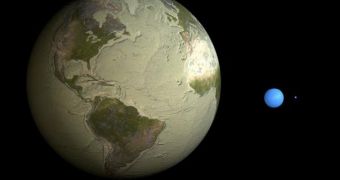A recent investigation by American researchers has shed some new light onto the planet's water supplies. Though they may seem considerable at first, in this case looks can be extremely deceiving.
Investigators from the United States Geological Survey (USGS) showed in the report that our planet features a volume of about 326 million cubic miles (1.332 billion cubic kilometers) of water.
While this may seem significant at first, the entire amount of water could in fact fit into the volume of a ping pong ball, if the planet is thought off as a basketball.
Even if approximately 72 percent of Earth's entire surface is covered in water, the layer is not very thick. The average depth of the water is 2 miles, or 3.2 kilometers.
If poured and contained across the surface of the United States, all of the world's waters would create a lake some 145 kilometers, or 90 miles, deep.
“There's not a lot of water on Earth at all,” explains scientist David Gallo. He holds an appointment as an oceanographer at the Woods Hole Oceanographic Institution (WHOI), in Massachusetts.
He goes on to compare the ratio of ocean thickness to the diameter of the planet to the ratio between an entire apple and its skin. This is how thick the oceans are in comparison to the other layers of Earth.
On average, the layer of water on the surface of the planet is thinner than the crust on which it resides, which is in turn thinner than the mantle – the inner layer separating the crust from the core.
Also worth noting is the fact that 97 percent of the water reserves are salty, and therefore unfit for human consumption. Complex life cannot thrive without clean water, and there are only limited amounts of that available.
“For humanity to thrive, or even exist, we need to sprinkle that teeny bit of fresh water in the right places, at the right times and in just the right amounts,” Gallo explains.
To make matters worse, of the 3 percent freshwater, more than 70 percent is trapped is glaciers and ice sheets. In addition, large amounts of freshwater exist underground, in aquifers, and not in lakes or ices.
The research also shows that Brazil, Russia, Canada, Indonesia, China and Colombia have control of over half of the world's freshwater reserves between themselves, OurAmazingPlanet reports.
When put in this perspective, the water crisis plaguing the African continent, or other areas of the world, catch on new meaning.

 14 DAY TRIAL //
14 DAY TRIAL //